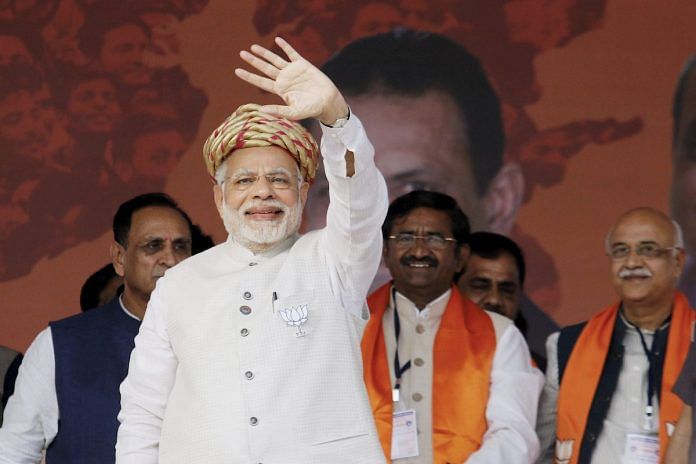Hyper-nationalism and aggressive identity politics in the Gujarat elections, such as ‘Gujarati Asmita’, can disintegrate the nation and the idea of India itself.
Prime Minister Narendra Modi, who is fond of describing himself as the leader of 125 crore Indians, has suddenly started emphasising his Gujarati identity and urging the voters to respect ‘Gujarati Asmita’.
Is he conceding that the so-called development model was yet another ‘jumla’?
Indeed, it is distinctly possible that a large number of voters may choose identity over the frustrations and disillusionment of the last three years. But if the BJP wins its own majority (whatever be the margin), Modi will say it was a victory of the Gujarat Model.
Identity politics, at once, gives unity and strength to the community, caste, religion, or language group, but it also divides the society, sometimes leading to violence. National leaders generally do not (or at least should not) narrow their Indian identity. Jawaharlal Nehru did not present himself as a Kashmiri Pandit. Neither did Narasimha Rao flaunt his Telugu character. Nor did Manmohan Singh project his Sikh identity.
But the fact is that identity politics is spreading rapidly across the country, often further degenerating into micro-identities. V.S. Naipaul had written about the million mutinies in India, but now these mutinies are becoming a million identities, often at conflict with each other.
Whatever the results of Gujarat elections, there is a very deep cleavage in Gujarati society. Patidars, under the leadership of Hardik Patel, are up in arms for reservations, Thakurs have mobilised themselves under Alpesh Thakor as a parallel community, as have the Dalits under the leadership of Jignesh Mevani. Rahul Gandhi does not have a specific identity in Gujarat or anywhere. But will Modi succeed in uniting all these micro-identities under the umbrella of Gujarati Identity?
In Rajasthan, the Rajputs are raising their swords to defend their military identity by protesting against the film Padmavati. In Haryana, Punjab, and UP, the Jats have risen to demand reservation. In Maharashtra, nearly four crore Marathas (equal to California’s population) have taken out huge marches across the state.
Darjeeling is burning over the separate identity of Gorkhaland. Jammu and Kashmir is seeking independent recognition for Kashmiriyat, as Pandits in Jammu are opening their decades-old wounds.
Can Hindus be united across India, beyond their ‘original’ identity of caste? The attacks on the lower caste-communities among the Muslims have shown that even Islam has failed in creating a monolithic Muslim society. Not many people even know that the Muslims in India are divided further by language, caste, region. Many southern Muslims do not know Urdu, and Shias maintain a separate identity. There is a Muslim OBC front, as also a Christian OBC movement.
At the time of independence, many British thinkers and newspaper commentators used to say that India will balkanise itself. But actually, Yugoslavia balkanised in the 1990s, and as many as seven independent republics were born. The Soviet Union disintegrated in 15 independent republican identities. Brexit also was an explosion of identities in the European Union. Catalonia has exploded in Spain, and the Scots are demanding independence from the UK. And if there is another referendum in Quebec, nobody can be sure that it would choose to remain in Canada.
So far, at least, India has remained united.
Oscar Wilde had said that “most people are other people”. Amartya Sen has warned us in his book titled ‘Identity and Violence: The Illusion of Destiny’ that “many of the conflicts and barbarities in the world are sustained through the illusion of a unique and choiceless identity. The art of constructing hatred takes the form of involving the magical power of some allegedly predominant identity that drowns other affiliations, and in a conveniently bellicose form can also overpower any human sympathy or natural kindness that we may normally have”.
The routine and increasingly strident statements against Muslims, particularly after the demolition of the Babri Masjid exactly 25 years ago, and the language of ‘love jihad’ and rapid marginalisation of the community is clearly a threat to the ‘unity in diversity’ idea of India. After the Uttar Pradesh municipal election results, Hindutva leaders have begun to publicly say that “Mandir wahin banayenge”, whether the Supreme Court gives a favourable verdict or not.
If the PM chooses to highlight being a Gujarati, then he cannot ask Yogi Adityanath to tone down his language of aggressive Hindutva, and will not be able to rein in Bengali nationalism.
It is rather disturbing, if not dangerous too, that the identity question has got badly mixed up with stereotyping of communities and castes. For example, the moment Gujarati Asmita is invoked, the image that comes upfront is that of a trader or bania or a stock broker and, of course, an industrialist. This is obviously wrong. Gujarat does not have six crore traders or banias. There are farmers, Dalit bonded labourers, factory workers, professionals, craftsmen etc.
But stereotyping is a global pastime. We have sweeping images of the Japanese, Chinese, Russians, Germans, and so on. Identitarianism gets completely confused with images and prejudices. The media in India promotes these stereotypes as well, creating ‘echo chambers’ that distort the sociological reality and electoral forecasts.
Nationalism can unite people and the nation. Hyper-nationalism and aggressive identity politics can disintegrate the nation and the idea of India itself.






